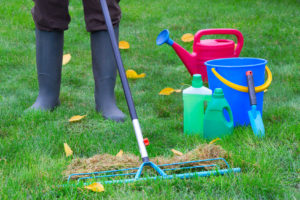As a homeowner, there is a lot to know about lawn care if you want a beautiful-looking yard. One of those things is aeration. Knowing what it is, when to do it, and if you need it are good to know so that you can have, not only a beautiful yard, but also a healthy lawn. Central Services, the expert in lawn care and lawn maintenance, offers aeration services and can help you determine if your lawn would benefit from an aeration treatment. Here are four facts you should know about aeration.
Fall Lawn Care Archive
Tips for Fall Mulching
Mulching is a great way to protect your plants and nourish your soil in anticipation of winter. During the winter, the ground is in a constant cycle of freezing and thawing, and mulching helps to prevent extreme temperature fluctuations in soil that stress your plants out.
How to Get the Most Out of Your Mulch This Fall
1. Mulch With the Best Materials Available to You
Straw is preferable to leaves, which compact, provide less absorption, and resist absorption. If you do decide to use leaves, it is recommended you shred them to help them decompose more quickly, or combine them with other materials (such as straw). Grass clippings and animal manure are also good choices.
Wood by-products, such as bark chunks (pine bark is an especially good choice), provide good insulation. Your local tree service may be willing to provide you with wood chips for cheap or even free.
2. Don’t Mulch Too Deeply
Remember that while you want to have maximum insulation, you also want any excess moisture to evaporate. If you mulch too deeply, it is more difficult for this vital evaporation to occur. The recommended mulch depth is 3 to 4 inches for medium- to coarse-textured materials.
3. Anchor Your Mulch
You want something that won’t blow away come the first winds of winter. Shredded leaves and straw, while good mulching materials, can blow away easily. If you live in a windy area, you may want to consider anchoring your mulch with chicken wire or other material available to you.
4. Don’t Let Mulch Pile Up Around the Trunks of Trees or Bases of Shrubs
This is often referred to as volcano mulching. Volcano mulching will keep your trees and shrubs from drying out properly and can also create the perfect conditions for rot and disease. The mulch area should extend to the drip line of the tree branches or cover a 4- to 5-foot diameter around the trunk.
5. Stay Away From Moldy Leaves
If your leaves have started to decompose, you may not want to use them. Leaf mold compacts tightly and creates a barrier between the air and the soil.
6. Organic Mulch Should Be Composted or Treated Before Use
This will kill insects, weed seeds, and disease mircroorganisms. Composted mulch also tends to have a more uniform texture.
7. Consider Mowing Fallen Leaves
This is an easy and effective way to mulch. Mowing shreds the leaves, allowing them to decompose over the winter. Your grass will thank you for this source of nitrogen in the spring.
8. Think About Your Mulch’s Presentation
While mulch’s functionality is important, you also want a mulch that is visually appealing in your landscaping. As mentioned earlier, composted mulch tends to have a uniform texture, which gives it better curb appeal.
9. Keep Your Mulch Thick
While many people try to save money by spreading a thinner layer of mulch, this doesn’t allow it to properly insulate roots and retain moisture loss. We recommended you maintain a 3-inch layer of mulch.
Remember: It Is Never Too Late to Mulch in Milwaukee
Even if it’s mid-winter, mulching will have a positive impact on your plants come spring. Mulching will ultimately make your spring better and more beautiful.
Follow some or all of these tips to properly mulch your yard in anticipation of the harsh winter ahead. And get over those winter blues by checking out some of our spring landscaping ideas.
5 Ways to Control Lawn and Garden Bugs in Fall
When it comes to bugs in fall, there’s a whole world of insect maintenance you’re going to want to be ready for. In any garden, there are two things you can always rely on: You need a watering system, and you’ll find pests somewhere.
So, today we’ll be looking at five of the best ways out there to keep these plant-munching baddies at bay this autumn.
Getting Rid Of Bugs In Fall
Kick Them Out
The truth about pest management is that even good pesticides can often be ineffective.
There’s a simple answer if you have relatively few bugs and aren’t too squeamish: Simply pluck them off. With a bucket or other container, take a walk through your garden and pick any bug that’s large enough off, by hand. Put it in a bag and take them all to a dump or safe location, far from your home and plants.
Keep Them Out
Sometimes, the best way to keep something out is a nice, solid door.
Well, in the case of pest control, maybe not a door. Row covers are lightweight sheets of fabric that are positioned above and around plants. These sheets are porous enough to allow light and air to pass through but work wonders at keeping out locusts, caterpillars, and other larger insects.
Don’t Encourage Them
Waste management is a bit of a tightrope for gardeners, but it’s one of the most important steps in stopping pest invasions.
First, never let waste pile up in or around your garden. This brings insects right to your door and can have a negative impact almost immediately. Be vigilant and remove rotting leaves, stems, or offcuts before they become a problem.
Next, pay very close attention to what goes into your compost heap. If the trash is being taken out of your garden, don’t put it into the compost that you’re putting back in your garden. These same insects will develop in the compost, and go right back into your garden’s ecosystem when you use it.
If your compost already has bugs in it, warm it up, wash it down, and then spread it out in a thin layer so that it can dry out.
Natural Pesticides and Insecticides
Of course, once you already have a problem, it helps to know how to take care of it.
There are all-natural and organic pesticide and insecticide options for gardens that already have insect problems.
Salt and/or garlic sprays have been shown to work well, or, if you’re willing to spend a little more, you may want to consider a good mineral oil.
Of course, a byproduct of any organic product is that they often don’t have the “staying power” of a more harmful chemical compound. You have to remember to apply these organic compounds more regularly in order for them to be effective.
Better Planting
There are also a few steps you can take while planting to prevent insects:
- After watering, space your plants out to give them more space to dry.
- Dry off your leaves to prevent fungal growth.
- Cut off and discard diseased plants as soon as possible.
- Test your soil regularly, and adjust the pH and mineral levels accordingly.
Bugs In Fall: Get It Under Control
Fall is a bad time for insects in any garden. Dying leaves, rotting mulch, and wet air all contribute to a pest revolution that will eat your yard whole if you leave them unchecked.
Hopefully, with a little help from us and our Milwaukee lawncare pros, you’ll have it all covered. Good luck out there!
How to Make Your Own Fall Lawn Fertilizer
It may sound too good to be true, but we promise it’s the real deal. Keep reading to learn how you can make the best fall lawn fertilizer right from your home.
If you’re like us, you love looking after your lawn. And with fall here, there’s nothing more satisfying than kicking off your shoes and running your toes through the soft, lush blades of grass. And, while you may think that fall means it’s time to stop caring for your lawn, you couldn’t be more wrong. But don’t go out to your local hardware store and spend tons of money on ineffective fertilizers!
You can simply make your own at home for the low price of, well, free.
Understanding Your Lawn
Just like people, certain types of grass require certain types of nutrition. If you have no clue what soil you’re working with, consult your zoning board. Chances are they have documentation that can help you along.
Now, you can’t use fall lawn fertilizer the same way you do in summer or spring. You’ll need to fertilize your lawn 6 to 8 weeks before the coldest months. This will likely vary by climate, so keep an eye on the forecast.
Use Household Goods
Here’s the good news: You can make an effective fall lawn fertilizer with things you likely have at home! Here are some of the most effective resources and recipes you can use for your fertilizer.
Coffee Grounds
Ahh, coffee. It wakes us up in the morning, keeps us focused, and grows grass? It may sound odd, but believe us, coffee grounds actually make for great fertilizer. So, next time you’re getting ready to throw out your old grounds, save them instead.
Use 1/2 pound as the foundation for a compost with grass clippings and add 5 gallons of water. Now, place the compost in a bucket and spread across your lawn evenly and gently. The water should break up the grounds. Make sure the grounds fall in between the grass, not on top.
Best of all, the coffee acts as a deterrent to pests! No more worrying about slugs, snails, and pesky insects.
Soda and Beer
Here’s a combo you’d never want to taste. While it may sound repulsive to your palate, your lawn will love it. A couple caveats: Make sure you’re using full-calorie cola and a darker beer. The chemical make-up will affect your grass otherwise.
Take 1 can/bottle of each, then combine them with half a cup each of ammonia, dishwasher soap, and mouthwash. The suds from the soda and beer will deliver nutrients while the ammonia produces nitrogen. Combine all into a spray bottle or hose and rinse your lawn.
Epsom Salt and Ammonia
Finally, you can use a simple combination of Epsom salt and household ammonia. Epsom salt brings nutrients like as magnesium and sulfur, while the ammonia will dilute the salt and introduce nitrogen.
Use about a cup of each and spread evenly over your lawn.
Need Some Help With Your Fall Lawn Fertilizer?
Using these recipes should get you results in a few weeks. Be sure to keep checking on your grass periodically and record your findings. You may have to vary the recipes slightly depending on your climate and soil types.
Of course, if you’re looking for some help, don’t be afraid to get in touch! Whether you’re inexperienced or simply don’t have the time, we can help.
We’d love to give you a hand in making your lawn greener and more gorgeous than ever. Get in touch today and see the difference a professionally maintained Milwaukee lawn can make.
Top 5 Tips for Lawn Care in Fall
Proper lawn care in fall will give you a healthy yard, increased value of your home, and a healthier body.
We get it: The summer is over, the kids are in school, and football graces television sets around the country four days a week. A glorious season, indeed. However, this is no excuse to ignore your lawn. In fact, your yard needs some special attention this time of year. Ignoring your lawn in autumn will result in extra work in the spring.
Here are five tips to handle your lawn care in fall.
1. Mow Lower
You want your grass to produce more nutrients in the summer. In autumn, however, drop it back down to 2 inches. This is the standard deck height for most mowers.
Don’t mow too short. A lawn cut too short in the fall will be a breeding ground for weeds.
If you don’t mow low enough, your yard will be ruined by leaves, winter snow, and be a safe haven for field mice.
2. Rake on the Reg
Some people love the appearance of fall. And yes, the leaves turning colors is pretty and will have an artistic look scattered around on your grass. However, allowing leaves to pile up on your yard is a bad idea.
Raking leaves is lawn care in fall 101. As they become wet and stick together, they form a mat-like surface that suffocates your grass. This will result in springtime patches, making your yard an eyesore.
3. Yoink Those Weeds
Many weed varieties go to seed in the fall. If you want to avoid a lawn in spring that’s full of weeds, get them in autumn.
If you’re averse to using chemical herbicides, a simple vinegar and water solution will do the trick. Just do your best to keep it on the weeds and not your grass.
4. Aerate the Soil
This isn’t an annual thing. Aeration is a part of proper lawn care in fall, but you really only need to do it every couple of years.
Essentially, this is just poking holes in your lawn. You can do it by hand with a border fork or rent a machine. The purpose is to loosen up your grass and create channels for water, oxygen, and fertilizer to ensure your lawn grows healthy and strong in spring.
5. Fertilization for Lawn Care in Fall
You shouldn’t care about the growth of your yard right now. For lawn care in fall, you want to worry about what’s going on beneath the surface.
Your lawn should be properly aerated. Now’s the time to capitalize on the previous labor. Fertilizing your lawn in the fall will allow your roots to grow quickly and be healthy. This is when you want to lay seeds in bald or thin spots. You’ll want to rake the soil so your seed and fertilizer can work quickly and effectively.
These are the secrets to building an amazing lawn. What you do in the off-season matters just as much as what you do in the spring and summer.
If you would like to find out more about our Milwaukee lawn care services, have questions, or would like to utilize our services, contact us today.






